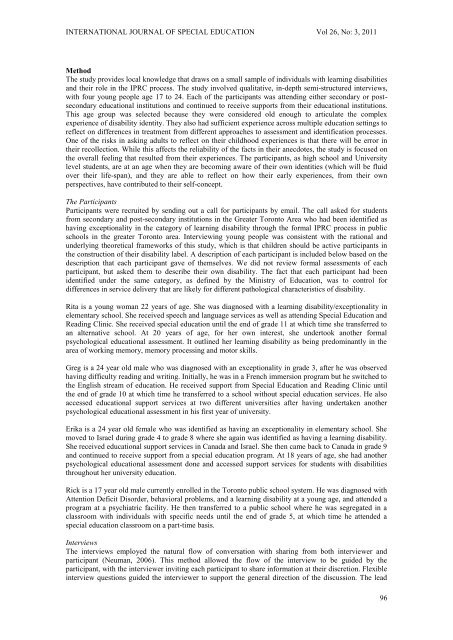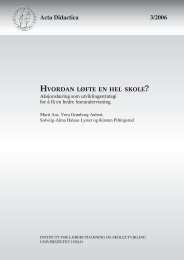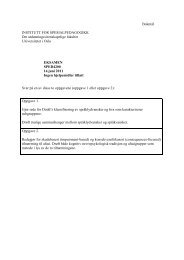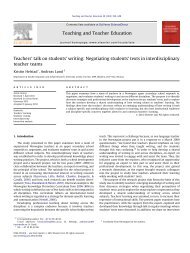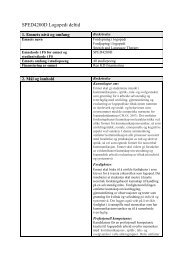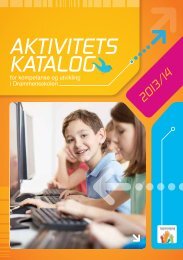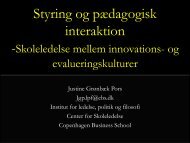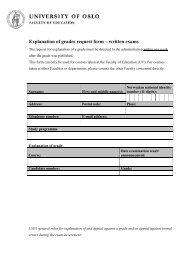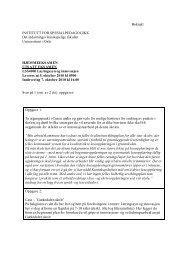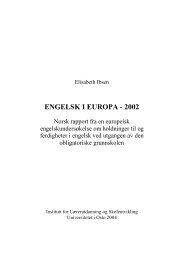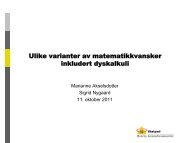International Journal Special Education
International Journal Special Education
International Journal Special Education
Create successful ePaper yourself
Turn your PDF publications into a flip-book with our unique Google optimized e-Paper software.
INTERNATIONAL JOURNAL OF SPECIAL EDUCATION Vol 26, No: 3, 2011MethodThe study provides local knowledge that draws on a small sample of individuals with learning disabilitiesand their role in the IPRC process. The study involved qualitative, in-depth semi-structured interviews,with four young people age 17 to 24. Each of the participants was attending either secondary or postsecondaryeducational institutions and continued to receive supports from their educational institutions.This age group was selected because they were considered old enough to articulate the complexexperience of disability identity. They also had sufficient experience across multiple education settings toreflect on differences in treatment from different approaches to assessment and identification processes.One of the risks in asking adults to reflect on their childhood experiences is that there will be error intheir recollection. While this affects the reliability of the facts in their anecdotes, the study is focused onthe overall feeling that resulted from their experiences. The participants, as high school and Universitylevel students, are at an age when they are becoming aware of their own identities (which will be fluidover their life-span), and they are able to reflect on how their early experiences, from their ownperspectives, have contributed to their self-concept.The ParticipantsParticipants were recruited by sending out a call for participants by email. The call asked for studentsfrom secondary and post-secondary institutions in the Greater Toronto Area who had been identified ashaving exceptionality in the category of learning disability through the formal IPRC process in publicschools in the greater Toronto area. Interviewing young people was consistent with the rational andunderlying theoretical frameworks of this study, which is that children should be active participants inthe construction of their disability label. A description of each participant is included below based on thedescription that each participant gave of themselves. We did not review formal assessments of eachparticipant, but asked them to describe their own disability. The fact that each participant had beenidentified under the same category, as defined by the Ministry of <strong>Education</strong>, was to control fordifferences in service delivery that are likely for different pathological characteristics of disability.Rita is a young woman 22 years of age. She was diagnosed with a learning disability/exceptionality inelementary school. She received speech and language services as well as attending <strong>Special</strong> <strong>Education</strong> andReading Clinic. She received special education until the end of grade 11 at which time she transferred toan alternative school. At 20 years of age, for her own interest, she undertook another formalpsychological educational assessment. It outlined her learning disability as being predominantly in thearea of working memory, memory processing and motor skills.Greg is a 24 year old male who was diagnosed with an exceptionality in grade 3, after he was observedhaving difficulty reading and writing. Initially, he was in a French immersion program but he switched tothe English stream of education. He received support from <strong>Special</strong> <strong>Education</strong> and Reading Clinic untilthe end of grade 10 at which time he transferred to a school without special education services. He alsoaccessed educational support services at two different universities after having undertaken anotherpsychological educational assessment in his first year of university.Erika is a 24 year old female who was identified as having an exceptionality in elementary school. Shemoved to Israel during grade 4 to grade 8 where she again was identified as having a learning disability.She received educational support services in Canada and Israel. She then came back to Canada in grade 9and continued to receive support from a special education program. At 18 years of age, she had anotherpsychological educational assessment done and accessed support services for students with disabilitiesthroughout her university education.Rick is a 17 year old male currently enrolled in the Toronto public school system. He was diagnosed withAttention Deficit Disorder, behavioral problems, and a learning disability at a young age, and attended aprogram at a psychiatric facility. He then transferred to a public school where he was segregated in aclassroom with individuals with specific needs until the end of grade 5, at which time he attended aspecial education classroom on a part-time basis.InterviewsThe interviews employed the natural flow of conversation with sharing from both interviewer andparticipant (Neuman, 2006). This method allowed the flow of the interview to be guided by theparticipant, with the interviewer inviting each participant to share information at their discretion. Flexibleinterview questions guided the interviewer to support the general direction of the discussion. The lead96


